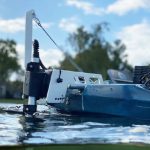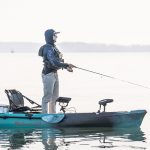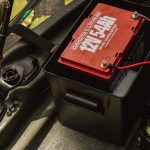Fishing from a motorized kayak offers many advantages. To get the best performance out of your trolling motor, you need to mount it properly.
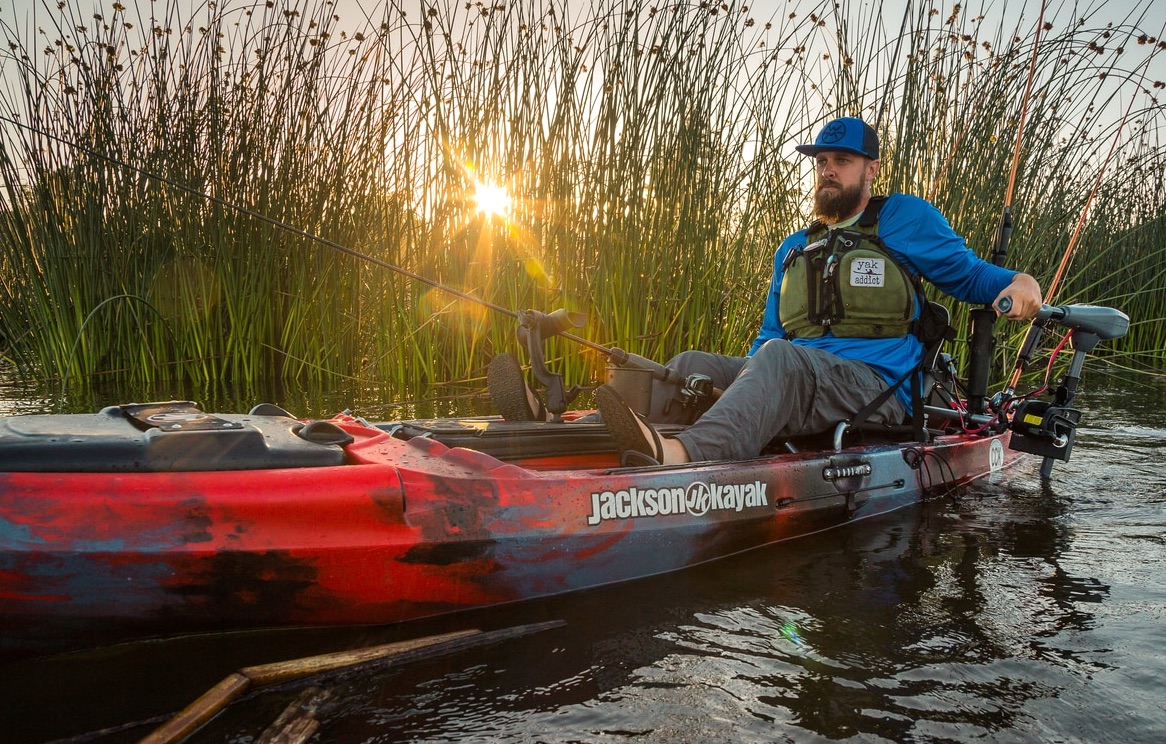
Want an upgrade that will take your paddling adventures to the next level? Then you need a kayak trolling motor!
Trolling motors are beautifully compact electric motors that you can mount on your kayak to add some extra oomph to your paddling—or really just cut out the paddling altogether.
With a kayak motor, you can zip up and down your favorite lake, river, or ocean coastline at top speed (not as fast as a proper motorboat, but faster than under paddle-power) and get to and from your fishing spots in a breeze.
No more paddling for hours and arriving exhausted to your fishing or hunting spot. Now, you can let the motor do all the work and you can focus on enjoying your day out on the water.
Below, we’re going to take a deep dive into all things related to kayak trolling motors. We’ll talk about what purpose they serve and what factors to consider when trolling motor shopping. Of course, we’ll also talk about how you can safely mount the motor to your kayak—or whether your kayak can even accommodate a mount in the first place!
By the end of this page, you’ll be armed with all the knowledge you need to get the best kayak motor for your paddling adventures.
As an affiliate of Amazon and other retailers, we may earn a small commission when you buy via our links, at no additional cost to you. Thank you!
At a Glance: Best Trolling Motors for Kayaks:
- Best Overall: Newport Vessels NV-Series 55lb Electric Trolling Kayak Motor
- Most Popular: Minn Kota Endura C2 30
- Best Lightweight Trolling Motor: Watersnake T18 ASP
- Best for Saltwater: Cloud Mountain 8 Speed Electric Trolling Motor
- Best For Fishing: Haswing Cayman Transom Trolling Motor (12V, 55lbs Remote-Controlled version)
- Best Bow-Mounted Trolling Motor: MotorGuide XI3
Other Kayak Motor Options
Comparison Table: Best Trolling Motors
| Model | Specs | Where To Buy |
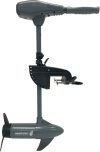 Newport Vessels NV-Series 55lb Electric Trolling Kayak Motor | Shaft Length: 24” Thrust: 55 lbs. Speed Settings: 8 Saltwater rated: Yes | Amazon |
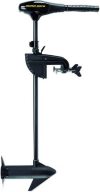 Minn Kota Endura C2 30 | Shaft Length: 30” Thrust: 30 lbs. Speed Settings: 5 forward, 3 reverse Saltwater rated: No | Amazon |
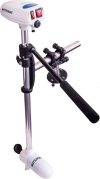 Watersnake T18 ASP | Shaft Length: 24” Thrust: 18 lbs. Speed Settings: 2 Saltwater rated: Yes | Amazon |
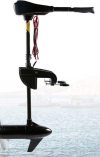 Cloud Mountain 8 Speed Electric Trolling Motor | Shaft Length: 28” Thrust: 40-86 lbs. Speed Settings: 8 Saltwater rated: Yes | Amazon |
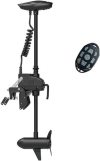 Haswing Cayman Transom Trolling Motor | Shaft Length: 39” Thrust: 55 lbs. Speed Settings: Variable speed Saltwater rated: Yes | Amazon |
 MotorGuide XI3 | Shaft Length: 48” Thrust: 55 lbs. Speed Settings: Unspecified Saltwater rated: No | Amazon |
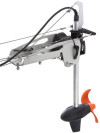 Torqeedo Ultralight 403 | Shaft Length: 18” Thrust: 33 lbs. Speed Settings: Unspecified Saltwater rated: No | FishUSA |
 Bixpy J2 | Shaft Length: No shaft, mounted directly to the kayak Thrust: equivalent to 32 lbs. Speed Settings: 12 forward, 3 reverse Saltwater rated: Yes | Eco Fishing Shop |
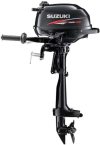 Suzuki DF 2.5 S Gas Outboard Motor | Shaft Length: 15” (38 cm) Thrust: 2.5 hp (about 160 lbs. of thrust) Speed Settings: Variable Saltwater rated: Yes | Amazon |
Best Trolling Motor for Kayak: Top Models Reviewed
Best Overall: Newport Vessels NV-Series 55lb Electric Trolling Kayak Motor

Shaft Length: 24” (61 cm)
Thrust: 55 lbs. (25 kg)
Speed Settings: 8
Saltwater rated: Yes
This Newport Vessels kayak trolling motor is among the most reliable and durable options on the market today. It generates up to 55 pounds of thrust and offers eight speed settings, with a 6-inch telescoping handle that makes precision steering an absolute delight. It even makes a little “clicking” sound to let you know when the gear has shifted or you’ve turned the motor off.
The motor comes with extra-long (5.5’) cables that make it easy to connect to the battery no matter where it’s stored and a 24-inch hyper-tough fiberglass shaft that makes it easy to adjust precise depth placement according to your preferences.
Best of all, it’s saltwater-rated, with an all-aluminum head and only corrosion-resistant zinc, magnesium, and stainless steel hardware that make it capable of withstanding the typical rust that accumulates with regular exposure to salt.
Pros:
- Excellent battery life
- Reliable and highly durable
- Premium customer service
- Adjustable shaft length
- Above-average thrust capacity
Cons:
- Heavier than smaller, lower-thrust motors
Most Popular: Minn Kota Endura C2 30 Freshwater Transom Mounted Trolling Motor
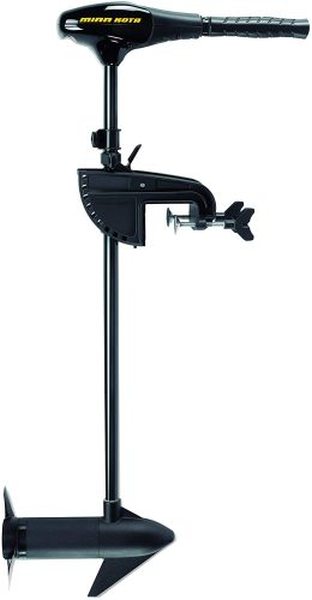
Shaft Length: 30” (76.2 cm)
Thrust: 30 lbs. (13.6 kg)
Speed Settings: 5 forward, 3 reverse
Saltwater rated: No
This is among the most popular kayak trolling motors on the market due to its affordable price tag, extra-long adjustable shaft length, and industry-leading reliability. It’s a motor you can trust to never give out on you even after years of regular use.
The “standard” C2 30 model generates just 30 pounds of thrust, but that’s more than enough to propel your kayak and as much gear as you want to load in. The 30-inch fiberglass shaft can be adjusted to your desired length, making it ideal for any water conditions, no matter how shallow or deep.
Battery life is excellent, as expected from one of the best-known brands in the trolling motor industry. Though it’s not saltwater rated, you’ll find it performs amazingly in freshwater, with 5 forward and 3 reverse speed settings that give you peerless maneuverability and steering. At just 17 pounds, it’s one of the lightest kayak trolling motors around.
Pros:
- Lightweight
- Ultimate reliability
- Adjustable shaft
- Top-notch build quality and trouble-free operation
Cons:
- Not saltwater rated
Best Lightweight Trolling Motor: Watersnake T18 ASP
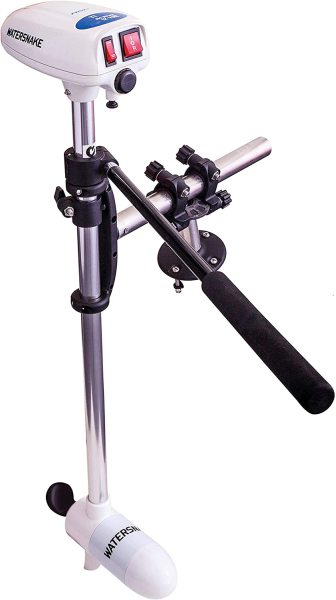
Shaft Length: 24” (61 cm)
Thrust: 18 lbs. (8.16 kg)
Speed Settings: 2
Saltwater rated: Yes
If you want a compact motor perfect to use only with a kayak, you’ll find this is one of the best options on the market, hands-down. It generates 18 pounds of thrust—enough to propel your kayak and gear, but never a larger boat—and weighs less than 5 pounds, making it perfect for anyone who wants to avoid overloading their kayak.
It’s rated for both freshwater and saltwater use and includes an adjustable mount compatible with most of the fishing kayaks on sale today. The 24-inch shaft is ideal for shallow waters.
Though it’s not the most feature-rich or powerful, it’s definitely an ideal trolling motor for small, lightweight kayaks.
Pros:
- Ultra-lightweight
- Reliable operation
- Great for ocean fishing
- High and Low speed settings; ultra-quiet
- Extendable, easy-grip handle
Cons:
- No built-in battery level indicator
- Lowest thrust rating on our list
Best for Saltwater: Cloud Mountain 8 Speed Electric Trolling Motor
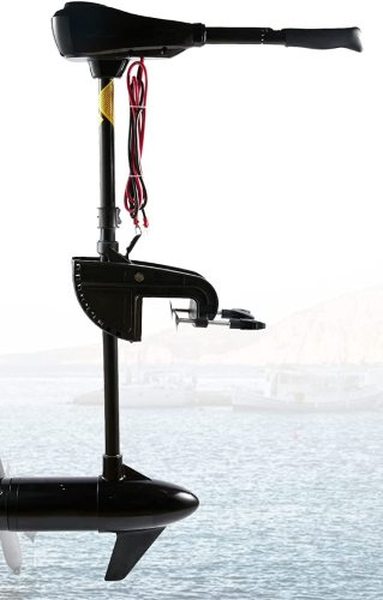
Shaft Length: 28” (71 cm)
Thrust: 40-86 lbs. (18-39 kg)
Speed Settings: 8
Saltwater rated: Yes
If you’re looking for a kayak trolling motor specifically designed for saltwater and deep sea fishing, the Cloud Mountain 8-Speed is your top pick. Everything is built using only marine-grade aluminum and stainless steel hardware that is rust-resistant and will never be worn down or corroded by exposure to saltwater or the salt-laden sea air.
The trolling motor comes in a thrust range from 40 to 86 pounds, meaning it’s more than powerful enough to propel your kayak or a larger, heavier boat if needed. With 8 speeds (3 reverse, 5 forward) and a high-tensile, corrosion-resistant 26-inch fiberglass shaft, it’s a trolling motor perfect for close-to-shore and out-at-sea use.
The shaft is fully adjustable, as is the telescoping tiller handle. Of particular usefulness is the 10-point LED battery indicator, which lets you know exactly how much charge your battery has left.
Pros:
- Compatible with most modern fishing kayak models
- Excellent thrust output
- Resistant to saltwater
- Highly durable materials and mounting hardware
- LED battery indicator makes it easy to keep an eye on power levels
Cons:
- Heavier-than-expected
- “Plastic-feeling” and potentially low-quality handle
Best For Fishing: AQUOS Haswing Cayman 12V Trolling Motor
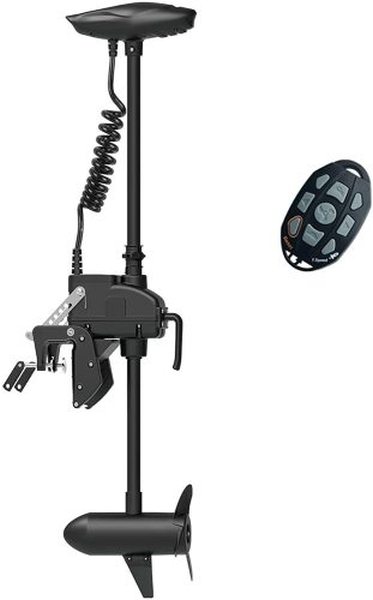
Shaft Length: 39” (99 cm)
Thrust: 55 lbs. (25 kg)
Speed Settings: Variable speed (no specific settings)
Saltwater rated: Yes
If you’re looking for a kayak trolling motor ideal for deep sea fishing, this AQUOS motor may be your best pick. Its 39-inch shaft is far too long to use in shallow water, but it will allow you to power even larger boats (up to 18’) through the ocean swells to reach your deep sea fishing spots. Mount it onto a kayak, and there’ll be nothing the open sea can throw at you that will stop you from getting out on the water.
The trolling motor features only forward speed control, but it’s variable speed that lets you “rev up” the motor the same way you would an outboard motor rather than sticking to specific speed settings. It’s great to speed up or slow down in a hurry if you need to beat a wave or cut free of a riptide.
There is also the option to buy the remote control-operated motor, which has a 164-foot wireless signal distance for easy, convenient hands-free use. It’s both saltwater and freshwater-rated, generates 55 pounds of thrust, and has enough power to get you where you need to go in a hurry.
Pros:
- Includes option for remote control
- Powerful 55-pound thrust capable of propelling larger boats
- 0 to 85-degree tilting position
- Variable speed
- Separated propeller/motor design protects you from injury
Cons:
- The included phone app can be buggy
Best Bow-Mounted: MotorGuide XI3
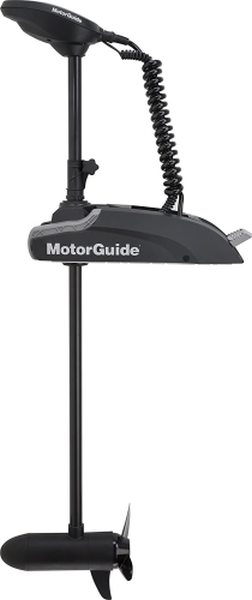
Shaft Length: 48” (122 cm)
Thrust: 55 lbs. (25 kg)
Speed Settings: Unspecified
Saltwater rated: No
For fishermen who want a bow-mounted motor unit that’s capable of doing a LOT more, check out the MotorGuide Xi3. Not only is it a highly powerful motor (55 lbs. of thrust), but it comes with a number of built-in (and add-on) features that make it ultra-convenient.
In addition to the steering tiller, the trolling motor includes a remote control that lets you operate your boat hands-free. You also get Pinpoint GPS (for an extra price) that not only improves navigation, but adds features like cruise control, “Jog”, precise anchoring at specific GPS coordinates, and Heading Lock that lets you set a destination and the motor will auto-steer in that direction.
The Digital Power Management feature will extend your battery life by up to 500%, and it runs as much as 40% quieter than competing models.
It’s definitely not the cheapest or lightest of the trolling motors on our list, and you may have to customize the mounting system to make it compatible with your fishing kayak. But for advanced features and a highly reliable bow-mounted motor, it doesn’t get better than this!
Pros:
- Included remote control, can add on Pinpoint GPS
- Compatible with both tiller and foot pedal
- Excellent thrust generation
- Quiet but surprisingly powerful
- Easy to deploy and stow
Cons:
- Pricey
- GPS has to be purchased separately
Other Reliable Options:
Torqeedo Ultralight
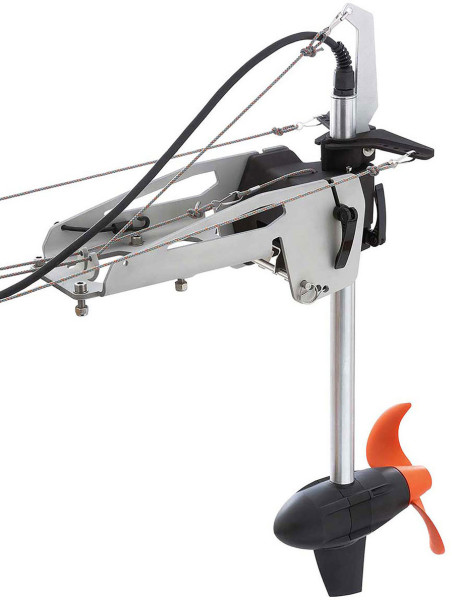
Shaft Length: 18” (45.7 cm)
Thrust: 33 lbs. (15 kg)
Speed Settings: Unspecified
Saltwater rated: No
This is a motor specifically designed for kayaks. In fact, it comes with “universal” mounting hardware and can be integrated with existing steering systems (skeg/rudder) to simplify the installation process. It includes both steering, tilting, and auto-kickup to maximize the handling of your boat and increase safety for both you and anyone else in the water around you.
The motor is compatible with the Bluetooth-enabled TorqTrac smartphone app, which turns the motor into an onboard computer and offers even more navigation options. It includes a remote control and is even solar-rechargeable!
Best of all, the motor and housing are completely dustproof and waterproof (IP67 rating) and hyper-durable.
Pros:
- Waterproof, solid build quality
- Compatible with smartphone app, turns it into onboard computer
- Remote control included
- Compatible with all fishing and hunting kayak steering systems
- Easy-to-mount
Cons:
- Very pricey
- Not saltwater-rated
Bixpy J2
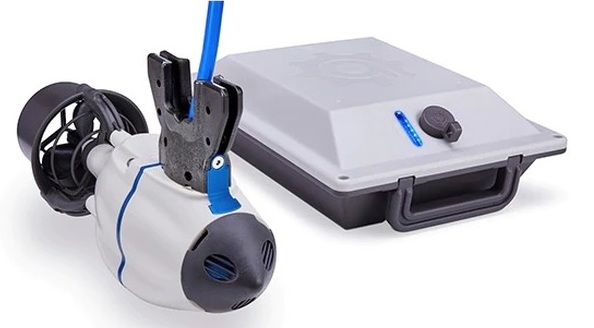
Shaft Length: No shaft, mounted directly to the kayak
Thrust: equivalent to 32 lbs. (14.5 kg)
Speed Settings: 12 forward, 3 reverse speeds
Saltwater rated: Yes
It’s no exaggeration to say that this is a kayak motor unlike anything else on our list! It’s not the standard trolling motor per se; instead, it’s a “jet propulsion” system that’s mounted on the keel or rudder of your kayak to serve as an undermount motor. That being said, it can be installed onto a PowerPole adaptor that turns it into a standard trolling motor if that’s your preference.
But for those who want the undermount-style motor, the remote control makes it easy to operate the Bixpy J2. The control gives you 12 forward and 3 reverse speed settings, and once in operation, the compact motor can generate up to the equivalent of 32 pounds of thrust. It comes with its own built-in battery and is designed to be easily mounted beneath your kayak, with a “magnetic kill switch” safety feature that immediately disengages and shuts off the motor in case of collision or contact.
It’s a bit heavier than expected (9 pounds) but is less than 1 foot long and delivers around 80 minutes of power at top speed, or up to 12 hours at slower speeds. Recharge time hovers around 5 ½ hours, so make sure to charge it the night before!
Pros:
- Compact and beautifully powerful
- No need for tiller or foot pedals; remote control makes steering a breeze
- Excellent handling
- Hyper-durable and reliable
- Good battery life
Cons:
- Requires compatible mounting hardware, or you’ll have to purchase separately
- Pricey
Suzuki DF 2.5 S Gas Outboard Motor
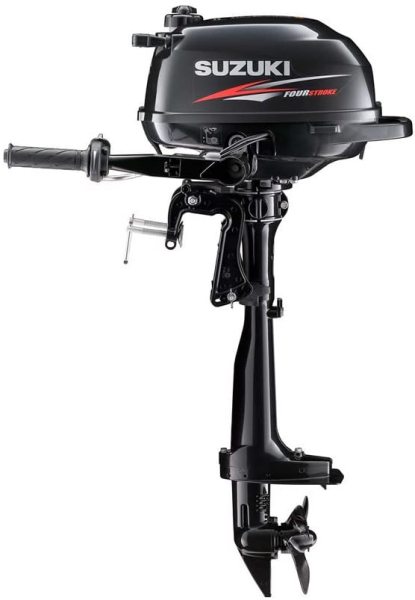
Shaft Length: 15” (38 cm)
Thrust: 2.5 hp, equivalent to roughly 160 lbs. (72.6 kg) of thrust
Speed Settings: Variable
Saltwater rated: Yes
Just in case you’re considering a gas-powered outboard motor, we’ve made sure to include this top-quality model on our list! Not only is it hyper-powerful (2.5 hp, or the equivalent of around 160 lbs. of thrust), but it’s lightweight (just 29 pounds), has a short enough shaft (15”) that it can be used in even shallow water, and is reliable enough that it will likely be the last kayak motor you’ll need to buy.
The 68cc motor is water-cooled so it will never overheat on you, even on a scorching summer day. It uses regular unleaded gasoline (87 octane) instead of two-stroke mixtures, making it more eco-friendly. Despite its power, it’s sized for smaller watercraft (including kayaks and canoes).
Pros:
- Hyper-powerful; a good option if you want gas-powered
- Great price for top-notch quality
- Built-in quarter-gallon fuel tank
- Runs on standard gasoline
- Twist-grip throttle for easy control
Cons:
- Often out of stock, hard to find
- Idles fast, engine may jerk when shifted into gear
The Ultimate Guide to Choosing a Kayak Motor
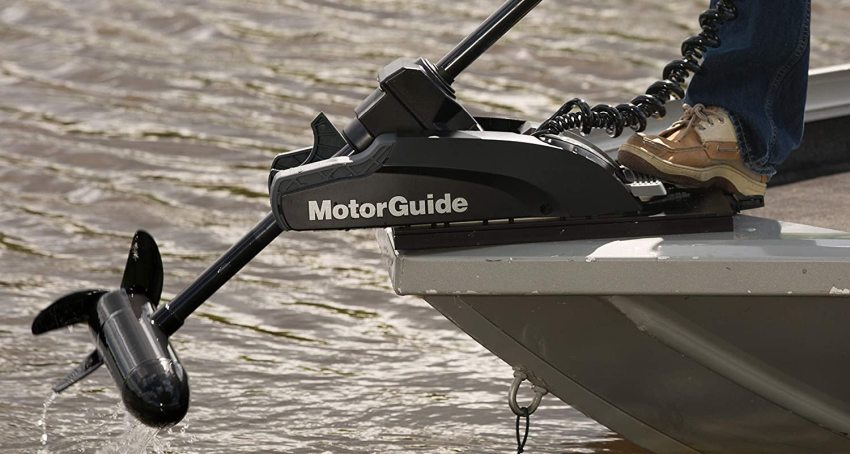
Trolling Motor vs. Outboard Motor: What’s the Difference?
I’ll admit it: I found myself asking this exact question! At first glance, outboard motors and trolling motors look pretty similar. However, the more I delved into the topic, the more I came to understand the fundamental differences between the two—and it made perfect sense why kayakers would prefer a trolling motor to an outboard motor.
Let me explain…
Both outboard and trolling motors are a self-contained motor unit (consisting of engine, gearbox, and propeller) that are affixed to your boat (either the stern or bow) to propel your vessel through the water. They’re typically attached to a pivoting mount that allows you to steer the boat, and which can be tilted to a higher position to avoid scraping the bottom in places where the water is very shallow.
However, there are a few differences:
- Trolling motors are typically electric battery-powered, while outboard motors are usually gas-powered
- Outboard motors need far more maintenance than trolling motors
- Spare batteries for trolling motors are far cleaner than additional gas for an outboard motor, but weigh more and occupy more space
- Trolling motors give far more maneuverability, while outboard motors deliver far greater speed
- Electric trolling motors are more eco-friendly and quieter, thus less likely to scare away fish
- Outboard motors can handle rough waters, while trolling motors are built for calmer waters
- Outboard motors tend to be far pricier, but have a longer lifespan
Both options are available for kayaks, as you’ll see on our list above. Our top picks are all trolling motors because they just make better sense for kayaks—they’re lighter, more compact and portable, quieter, and maneuverable. However, we’ve included a few outboard motors just in case you really want to add some VROOOM to your kayak.
Why You Want a Trolling Motor

Let’s be honest: not every kayaker needs a trolling motor.
In truth, they’re a fancy add-on that makes certain kayaking activities easier, but which you can absolutely live without.
If you’re a recreational kayaker who likes to enjoy the calm lakes and slow-moving rivers in your area, chances are the paddling is actually part of the fun. For me, personally, I love working up a good sweat and pushing myself to paddle faster, farther, and for longer. I’m not in the water to fish or hunt, but to enjoy the beauty of the lake or river, sunshine, the cool breeze, and a great workout.
But for fishermen and hunters, a trolling motor is an excellent upgrade to their kayak, for a number of reasons:
1) No paddling needed. Paddling can be tiring, especially if you’re paddling across a choppy lake or up a fast-flowing river. If you expend a lot of energy getting to your fishing spot or hunting hide, you might be too tired to enjoy the real reason you’re out on the water. Having a trolling motor will let you arrive at your “honey hole” fresh as a daisy and ready for a long day of hunting or fishing.
2) Cover more distance faster. Early morning is often the best time for fishing, and some of the best hunting happens in the last couple of hours of the evening before full dark sets in. For fishermen wanting to catch the early fish, a trolling motor saves you from having to get up in the middle of the night just to paddle out to your fishing spot to be in place by 5 AM. Hunters can enjoy their late-afternoon hunting without having to paddle for hours in the dark. Thanks to the trolling motor, you can zip to and from your hunting and fishing spot much faster than you would with a paddle. And best of all, you’ll arrive fresh and ready for some action!
3) Free up your hands. Fishing can often be a two-handed activity, especially if you’ve got a particularly feisty catch on the hook. And you definitely need two hands to hold a rifle or shotgun for your kayak hunting adventures. Instead of worrying about trying to switch between your paddle and gun or fishing pole, a trolling motor lets you travel (mostly) hands-free and focus on your task at hand.
If you use your kayak for fishing, hunting, or travel (especially upstream or against the current), a motor can make a world of difference!
Factors to Consider When Choosing a Kayak Motor
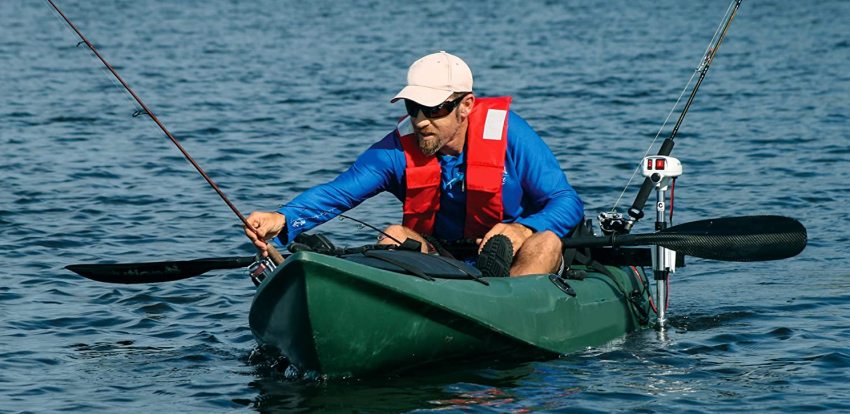
Thrust
The term “thrust” refers not to how fast the motor can propel your boat, but how much boat the motor can propel.
There’s a pretty simple formula to follow: for every 100 pounds of weight, you need roughly 2 pounds of thrust. So, for example, a kayak weighing 50 pounds and loaded with 350 pounds of paddler, PFD, gear, supplies, and the motor itself, you need a MINIMUM of 8 pounds of thrust.
The good news is that most kayak trolling motors have significantly more than just 8 pounds of thrust! You’ll find motors with a thrust of 30, 55, or even 86 pounds—all definitely sufficient to propel your kayak through the water.
The larger the motor, typically the greater the thrust it is capable of generating. Higher thrust may mean you can reach higher speeds (though it’ll top out at max speed fairly quickly), but for electric motors, speed is a metric considered far less important to measure than thrust. What manufacturers care about is making sure you know just how much weight your motor is capable of propelling.
Voltage
Electric trolling motors are battery-powered, and they typically run in multiples of 12 (because of the 12V batteries that are standard everywhere). You can find 12-volt, 12/24-volt, 24-volt, and 36-volt battery systems.
RELATED: Don’t miss our roundup of the best trolling motor batteries.
Essentially, the higher the battery voltage, the more power it’s capable of generating, so the larger the motor it can run.
For kayaks, you’re best off with a 12-volt trolling motor. The higher-powered motors won’t really give you much better speeds, just greater thrust (as we explained above) necessary for propelling larger, heavier boats. The batteries are also very heavy, so they’ll weigh down your kayak. A smaller trolling motor that operates on a single 12V battery is ideal for kayakers who want to zip around and minimize unnecessary weight.
Shaft Length
Shaft length is an important factor to consider when trolling motor-shopping, for a few reasons:
1) A shaft that is too short will generate a lot more noise and perform less efficiently. If the propeller isn’t fully submerged, the blades will be much noisier because they’re striking the surface. Also, blades that aren’t fully submerged will move air as much as water, so your propulsion will be drastically reduced.
2) A shaft that is too long will scrape the bottom or make the motor uncomfortable to handle. Kayaks typically travel through shallow waters, so a trolling motor attached to a too-long shaft could end up grating against the river or lake bed and breaking. Or, if you try to mount it higher, you end up sitting in an awkward position with your arm too high so that you can reach the tiller.
Ideally, the propellers should be submerged roughly 12 inches beneath the water’s surface. This will reduce noise, maximize propulsion, but also give you enough maneuverability that you won’t have to worry about the trolling motor hitting the lake or river bed.
This means that you need a shaft AT LEAST 12 inches long, but we’re just getting started. You also have to factor in the distance between the mount on your kayak and the waterline. Typically, that will be another 6-12 inches (depending on your kayak model and the mount).
Doing all this math, you can see that the ideal shaft length is around 18 to 24 inches for mounting a trolling motor on your kayak.
Speed Settings
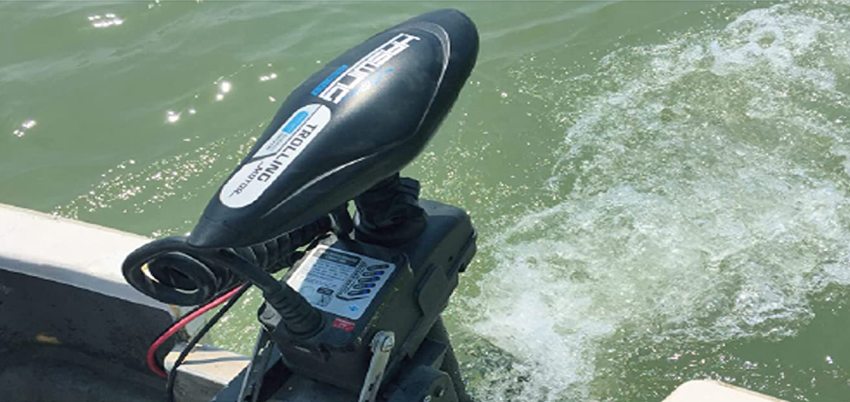
Some trolling motors are “fixed speed”, meaning they have just one speed setting. However, many of the better-rated motors come with variable speed settings that let you adjust just how fast you want to go.
More speed settings can be a good thing if you’re using your kayak for fishing or hunting. You can use the lowest speed setting to slowly drift along and drag your bait behind you, or zip off at top speed to travel to and from your fishing spot or hunting hide.
Motors with multiple speed settings also typically have longer battery lives, as slower speeds will use less power and thus drain the battery more slowly.
Important: I want to take a moment here to talk about speed. As I mentioned in the “Thrust” section, trolling motors are rated for pounds of thrust, not top speeds. The higher the thrust, the greater the capacity for higher speeds, but that is affected by things like water conditions, the weight you’re carrying, even how much your battery is charged.
Typically “top speed” is around 5 MPH for a trolling motor ranging between 30 and 55 pounds. Larger trolling motors (70-86 pounds of thrust) can reach speeds of around 8-9 MPH, but those are often very large and too heavy to mount on a lightweight kayak.
Mounting System Compatibility
Let’s get real for a second: not every kayak is compatible with a trolling motor!
In fact, the vast majority of recreational and expedition kayaks CANNOT have a trolling motor mounted to them because they’re just not designed to accommodate a mounting system.
Note: Some trolling motors are designed to be bow-mounted on fishing boats, and you may need to purchase the transom-mounting system separately. Or, you might have to build your own custom mounting system—like they do in this awesome video from Rated Red.
While trolling motors are typically mounted to the bow on standard boats, kayaks will have to install them along the side of the boat (with the tiller within easy reach of your cockpit) so you can steer from a seated position rather than from the rear of the boat.
However, there are some specialized mounts that allow you to secure the trolling motor to your bow or stern using clamps. These may require you to drill holes into your kayak, as well as install some form of steering linkage for foot pedal operation.
RELATED: Best Kayak Trolling Motor Mounts for 2023
Control Options
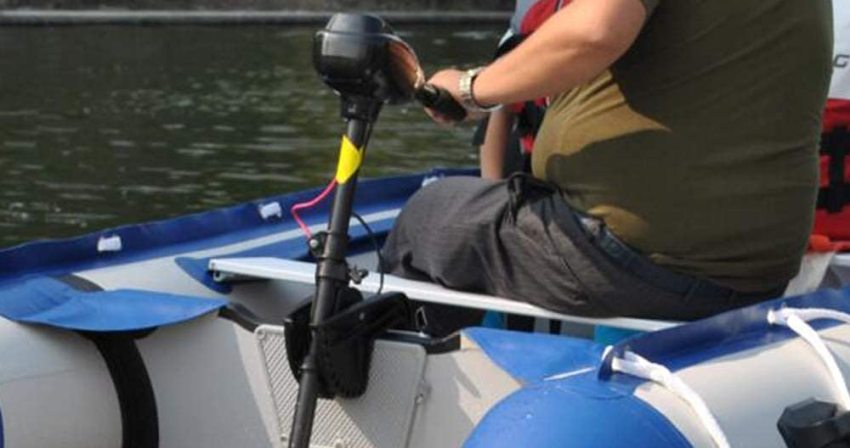
Trolling motors for kayaks typically feature one of two control options:
1) Tiller – This is the best option for kayakers. The tiller is a handle affixed to the top of the trolling motor, which allows you to manually steer or raise the motor. The tiller typically sits alongside your seat, within easy, comfortable reach.
2) Foot pedal – Foot pedals are intended to be used with bow-mounted trolling motors. They are operated from a standing position as you stand and fish. If you push the pedal while standing on your kayak, it can propel the boat forward with power enough to knock you off-balance and send you toppling into the water.
2) Remote control – some trolling motors come with a remote control. It allows you to steer your boat using only the buttons on the remote rather than having to press a foot pedal or grip a tiller handle.
Remote-controlled trolling motors are great for kayak anglers who want to move their kayak without touching the motor. You can motor along and keep fishing. Remote controls are especially useful with bow- or stern-mounted motors that are harder to reach.
Saltwater Compatibility
Trolling motors come in both saltwater and freshwater models. They operate virtually the same, but with one difference: on the saltwater models, corrosion-resistant materials are used to protect the motor from being damaged by the salt.
If you’re going to be fishing in saltwater (oceans, seas, bays, etc.), it’s absolutely worth investing a bit more into the saltwater models. It’ll extend the lifespan of your trolling motor significantly! Otherwise, if you’re exclusively going to use it on freshwater, you can opt for the budget-friendly freshwater-only models.
Weight
Weight is always a factor to consider when adding anything onto your kayak. Too much extra weight will slow you down or even cause you to sink/topple. You need to make sure your kayak can handle the weight of the motor on top of your weight and that of your supplies, PFD, and gear.
Make sure to check your kayak’s weight capacity, weigh your gear, and check the trolling motor specs to make sure it won’t overload your kayak!
ALSO SEE: What’s the Right Kayak For Your Weight? Why Weight Limit Matters
Number of Propeller Blades
Trolling motors typically come with 2- to 4-blade plastic propellers.
The number of propeller blades isn’t a major factor to take into account, but there are a couple of reasons to consider it:
- More blades may equal greater thrust
- More blades are more resistant to damage and less likely to break or get fouled up by grass or seaweed
What Battery Do You Need for a Trolling Motor?
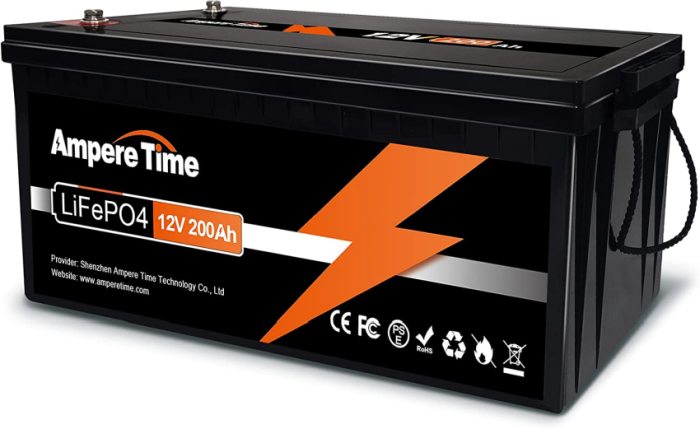
Above, we talked a bit about the battery voltage standard for trolling motor batteries. But I want to highlight a few more important details about the types of batteries used for trolling motors.
Trolling motors operate on 12V batteries very similar to car batteries. But don’t think you can just grab the battery out of an old car and attach it to your trolling motor.
Trolling motors use “deep cycle” batteries—meaning the batteries can be discharged almost completely multiple times. As you know, fully discharging a car battery will kill it very quickly.
In terms of technology, there are two main choices: traditional lead-acid batteries and lithium batteries.
1) Absorbent Glass Mat (AGM) – AGM batteries have a fairly long charge, good lifespan (3-4 years), and require zero maintenance. They’re high-performance batteries that cost more but deliver reliability for as long as they last.
2) Lead Acid Wet-Cell – Lead Acid Wet-Cell batteries are the “budget-friendly” option used by many low-end trolling motors. They’re capable of enduring regular draining and recharging and have a lifespan of 2-3 years. However, they require regular maintenance (filling the water inside) and may spill over and leak battery fluid into your kayak—or, worse, the water.
3) Lithium (LiFePo4) – Lithium iron phosphate batteries are 70% lighter than the other two battery types, last up to 10 years, have full power regardless of how much charge is left in the battery, and occupy less space in your kayak. They’re the priciest option on the market, but also the best for kayakers looking to minimize the engine footprint and maximize performance.
If you’re interested in this topic, we have a separate post covering the best batteries for trolling motors.
Whatever battery type you choose, I highly recommend you consider also purchasing two more battery-related products for your kayak:
The Minn Kota 1820175 Trolling Motor Marine Battery Power Center is essentially a plastic battery box that protects your battery from water damage. It comes with built-in terminals that allows you to connect your motor with the battery inside the box, a handle for easy transportation, and a display that shows you just how much battery charge you have left at the push of a button.
The NOCO GENIUS10, 10-Amp Fully-Automatic Smart Charger is a portable battery charger compatible with all three battery types listed above. It can charge “dead” batteries (as low as 1 volt), restore battery performance, and reverse battery damage. If you ever find yourself running out of power in the middle of the lake or river, you’ll be glad you had this little device stowed in your dry bag!
FAQs
The battery life will depend on A) the amperage-hour lifespan of the battery, and B) the power draw. For example, a battery with a 100 amp-hour lifespan can run for 8 hours drawing just 12.5 amps of power, or 4 hours when drawing 25 amps.
The higher your speed, the more energy is drawn from the battery, so the faster it will run out. To conserve battery life, maintain slower speeds.
Inflatable kayaks are compatible with trolling motors, though you may need to reinforce the structure so the motor has a solid platform to push against. Without additional reinforcement and proper motor placement, the motor could actually tear the fabric of the inflatable kayak.
Yes, it is fully legal to install a trolling motor on your kayak (or paddleboard or canoe) in all 50 U.S. states and Canada.
Absolutely! Because you’re adding a motor, it becomes a “motorized” vessel as opposed to “paddle-powered” vessel, and thus needs to be registered with your local Small Vessel Register.

